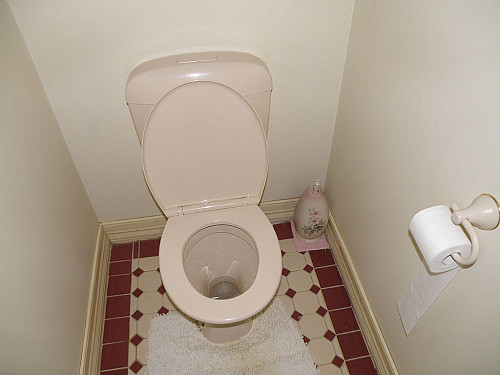Troubleshoot A Toilet Leaking At Its Base
 What’s that mysterious wet patch on the bathroom floor? At first a little dampness may be easy to dismiss as splashing from your shower or a toddler’s "accident," but sooner or later, you have to investigate further. And … yep, it seems like the cause is your toilet leaking at the base. Sigh!
What’s that mysterious wet patch on the bathroom floor? At first a little dampness may be easy to dismiss as splashing from your shower or a toddler’s "accident," but sooner or later, you have to investigate further. And … yep, it seems like the cause is your toilet leaking at the base. Sigh!
Cheer up. Here’s how to troubleshoot and fix this watery problem.
Look At These Clues
Narrow down the source of the seepage. Dry off the toilet’s exterior, as well as the floor. As soon as you spot more water around the base, note the following two factors:
- whether the toilet has just been flushed AND
- where exactly the water seems to be coming from.
Toilet Leaking At Base Only When You Flush
If your toilet is leaking at its base only after you flush, the water is coming from the toilet bowl itself. Besides causing potential damage to your bathroom tile and subfloor, this type of leak is unsanitary. To put it bluntly: the leakage consists of water mixed with urine and/or feces and contains viruses and bacteria which may cause disease. Repair without delay.
These are the causes and cures:
1. Loose mounting bolts. The first potential solution is to pry off the caps of the mounting bolts (also called tee bolts or closet bolts) that hold the toilet to the floor. Then gently tighten the bolts before replacing the caps.
2. Worn out wax gasket. If tightening the bolts doesn’t help, you’ll have to take more drastic action – turn off the water supply, drain the water from the toilet itself, remove the toilet, take out the wax gasket that rests under it, and install a new one. Then put the toilet back in its place and turn the water on once again.
Toilet Leaking At Base All The Time
Water which is pooling around the toilet base all the time – not just after flushing -- is actually the sign of a leak which comes from another part of the fixture. While this is relatively clean water, it can still seriously damage your floor. Here are the most common sources, with fixes for each.
3. Loose water supply line connection. The supply line might be leaking at its connection to the toilet tank or the valve. Where the supply line connects to the tank, make sure that the nut is tight and the rubber seal is sound.
4. Problematic water shutoff valve. Test by placing a container underneath toilet valve. Try turning the valve to tighten it; be gentle, though. A valve coming off in your hand is seriously bad news. If tightening doesn’t solve your problem, you may need to replace the tube or the valve.
5. Faulty seal between toilet tank and base. This problem applies only to 2-piece toilets, that is, toilets where the tank is separate from the base – however, they are the most commonly used type. Check the bolts which attach your toilet tank to the base. If they’re loose, tighten them. Alternatively, the rubber seal between the two segments may have worn out or cracked. In that case, you will need to replace it.
Toilet Repair: DIY or Hire a Pro?
Toilet leaks are often fairly easy for the home handyperson to repair. Toilet parts tend to be readily available and inexpensive at hardware stores and home centers.
However, there are 2 major challenges when it comes to toilet repair. The first is identifying the source of a problem. The second is physically removing the toilet and repositioning if necessary. (Toilets are heavy and awkward to lift!)
Should you be up to DIY toilet repair, more power to you. However, if you’d rather not tackle this particular home maintenance project, find a licensed plumber in your area to take care of it for you.
Laura Firszt writes for networx.com.
Looking for a Pro? Call us (866) 441-6648

Average Costs
Related Experiences

Four Essential Points That Helped Me Install The Best Toilets

Kitchen Faucet Replacement With A Unique New Feature



